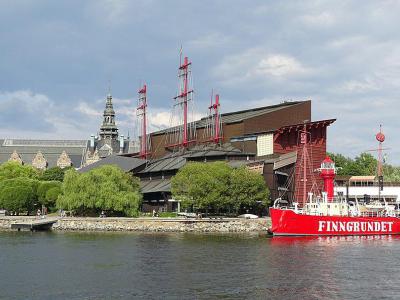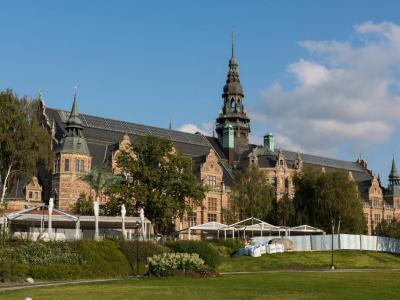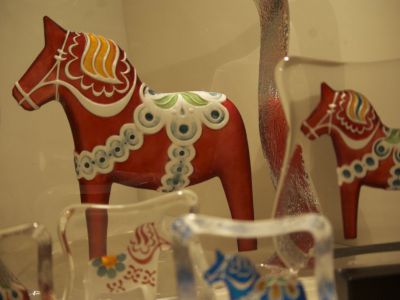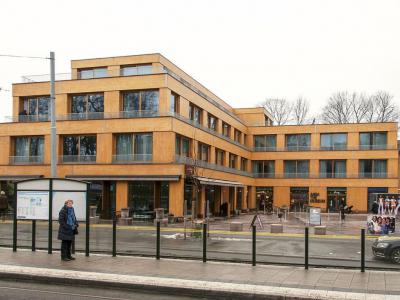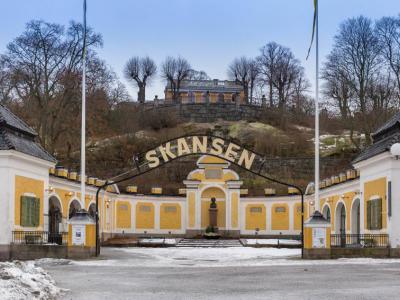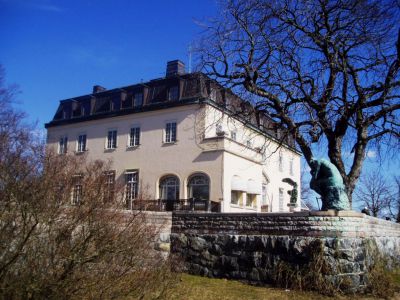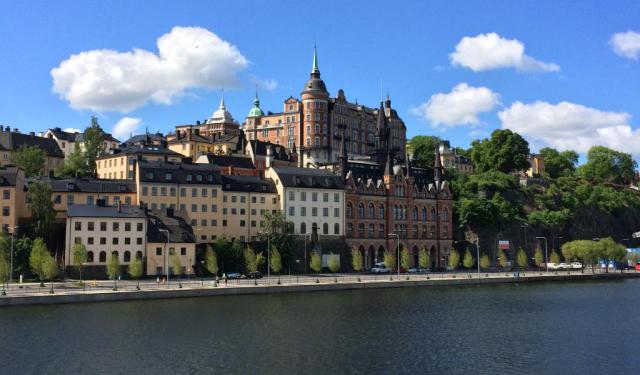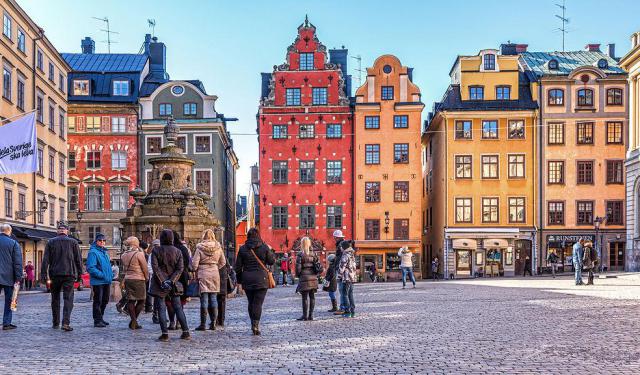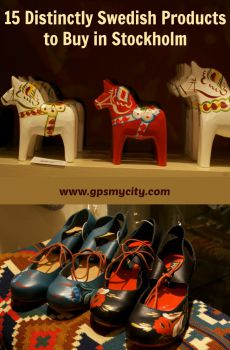
The Museums Island Walk (Self Guided), Stockholm
With almost 70 museums in operation, Stockholm is one of the richest (in terms of museums) cities on the planet. The island of Djurgården, a cultural hotspot inside the capital, also known as the Museums Island, is home to an array of museums and other cultural attractions suitable for visitors of all ages.
One of the most renowned venues on the island is Scandinavia’s most popular museum, the Vasa Museum. Its main exhibit is the remarkably well-preserved 17th-century warship, the Vasa, salvaged from the sea hundreds of years after she sank on her maiden voyage.
For families with young kids, Junibacken, or the Children's Museum, is a must-visit destination. Here, your “ankle biters” can immerse themselves in the magical world of Swedish children's literature, particularly the works of Astrid Lindgren, creator of Pippi Longstocking.
The Nordic Museum provides a fascinating glimpse into the cultural heritage of the Nordic countries, with exhibitions spanning from traditional folk costumes to contemporary design. Don't forget to stop by the Nordic Museum Gift Shop either to pick up unique souvenirs and gifts inspired by Nordic culture.
Music enthusiasts will delight in a visit to ABBA: The Museum, dedicated to the iconic Swedish pop group ABBA, featuring interactive exhibits, costumes, and memorabilia that celebrate the band's enduring legacy.
For thrill-seekers, Grona Lund amusement park offers a wide range of rides and attractions, while Skansen, the world's oldest open-air museum, allows visitors to step back in time and experience traditional Swedish life.
Art lovers will appreciate a visit to Waldemarsudde, a museum and art gallery showcasing the works of Swedish artist Prince Eugen, set amidst beautiful gardens overlooking the waterfront.
With so much to see and do on the Museums Island of Stockholm, there's something for everyone to enjoy. So, plan your visit today and discover the rich tapestry of Swedish culture waiting to be explored!
One of the most renowned venues on the island is Scandinavia’s most popular museum, the Vasa Museum. Its main exhibit is the remarkably well-preserved 17th-century warship, the Vasa, salvaged from the sea hundreds of years after she sank on her maiden voyage.
For families with young kids, Junibacken, or the Children's Museum, is a must-visit destination. Here, your “ankle biters” can immerse themselves in the magical world of Swedish children's literature, particularly the works of Astrid Lindgren, creator of Pippi Longstocking.
The Nordic Museum provides a fascinating glimpse into the cultural heritage of the Nordic countries, with exhibitions spanning from traditional folk costumes to contemporary design. Don't forget to stop by the Nordic Museum Gift Shop either to pick up unique souvenirs and gifts inspired by Nordic culture.
Music enthusiasts will delight in a visit to ABBA: The Museum, dedicated to the iconic Swedish pop group ABBA, featuring interactive exhibits, costumes, and memorabilia that celebrate the band's enduring legacy.
For thrill-seekers, Grona Lund amusement park offers a wide range of rides and attractions, while Skansen, the world's oldest open-air museum, allows visitors to step back in time and experience traditional Swedish life.
Art lovers will appreciate a visit to Waldemarsudde, a museum and art gallery showcasing the works of Swedish artist Prince Eugen, set amidst beautiful gardens overlooking the waterfront.
With so much to see and do on the Museums Island of Stockholm, there's something for everyone to enjoy. So, plan your visit today and discover the rich tapestry of Swedish culture waiting to be explored!
How it works: Download the app "GPSmyCity: Walks in 1K+ Cities" from Apple App Store or Google Play Store to your mobile phone or tablet. The app turns your mobile device into a personal tour guide and its built-in GPS navigation functions guide you from one tour stop to next. The app works offline, so no data plan is needed when traveling abroad.
The Museums Island Walk Map
Guide Name: The Museums Island Walk
Guide Location: Sweden » Stockholm (See other walking tours in Stockholm)
Guide Type: Self-guided Walking Tour (Sightseeing)
# of Attractions: 8
Tour Duration: 2 Hour(s)
Travel Distance: 3.3 Km or 2.1 Miles
Author: rose
Sight(s) Featured in This Guide:
Guide Location: Sweden » Stockholm (See other walking tours in Stockholm)
Guide Type: Self-guided Walking Tour (Sightseeing)
# of Attractions: 8
Tour Duration: 2 Hour(s)
Travel Distance: 3.3 Km or 2.1 Miles
Author: rose
Sight(s) Featured in This Guide:
- Vasa Museum
- Junibacken (Children's Museum)
- Nordic Museum
- Nordic Museum Gift Shop
- ABBA: The Museum
- Grona Lund
- Skansen
- Waldemarsudde
1) Vasa Museum (must see)
The Vasa Museum is a unique maritime museum experience; in fact, it is said to be the most popular museum in all of Scandinavia. It houses a 17th-century 64-gun warship that has been meticulously restored and preserved. It is a grand lady of the sea, measuring 69 meters and was built under the rule of King Gustavus Adolphus of Sweden. Intended to be the flagship of the Swedish Navy, the ship sunk on its maiden voyage, barely making it out of the harbor, when high seas and wind overtook its deck.
Vasa is filled with some of the most ornate and exquisite carvings ever seen on a ship of its kind. It is located in a climate and humidity controlled environment and is constantly monitored and maintained to keep it in the most ideal condition for a relic of its age. The ship is a terrific photographic subject but expect its interior to be dark, making it difficult to get that perfect photo. Besides the ship itself, the museum is filled with tools of the maritime trade and traces the history of Scandinavian maritime society.
Why You Should Visit:
It's not much of a stretch to say that there are not many ships available to examine that were built in 1628. Inside, there are several levels so you can see it from all angles.
As a bonus, at the back of the building, you can visit three interesting boats belonging to the Maritime Museum – and for free!
Tip:
Allow a couple of hours for the visit and therefore arrive 2/3 hours before it closes – it will be much quieter then.
Vasa is filled with some of the most ornate and exquisite carvings ever seen on a ship of its kind. It is located in a climate and humidity controlled environment and is constantly monitored and maintained to keep it in the most ideal condition for a relic of its age. The ship is a terrific photographic subject but expect its interior to be dark, making it difficult to get that perfect photo. Besides the ship itself, the museum is filled with tools of the maritime trade and traces the history of Scandinavian maritime society.
Why You Should Visit:
It's not much of a stretch to say that there are not many ships available to examine that were built in 1628. Inside, there are several levels so you can see it from all angles.
As a bonus, at the back of the building, you can visit three interesting boats belonging to the Maritime Museum – and for free!
Tip:
Allow a couple of hours for the visit and therefore arrive 2/3 hours before it closes – it will be much quieter then.
2) Junibacken (Children's Museum) (must see)
Junibacken is a children’s museum situated on the island of Djurgården in the centre of Stockholm. Officially opened by the Swedish Royal Family in 1996, it is Stockholm’s 5th most-visited tourist attraction. The museum is devoted to Swedish children’s literature, but especially Astrid Lindgren, whose bronze statue sits outside the building. The art direction and images for the interior design were made by Swedish artist Marit Törnqvist, who had previously made illustrations for more recent versions of Lindgren's books.
The museum contains the largest children’s bookstore in Sweden. The lockers in the entrance hall are unusual in that each is in the form of a giant book-spine, featuring world classics such as Treasure Island and The Jungle Book. Other main attractions include a Storybook Square, a mock public square where each house is devoted to a separate Swedish children’s author (other than Lindgren), from the earliest writers such as Elsa Beskow to recent writers such as Sven Nordqvist. The square ends at a mock Vimmerby railway station. The station also presents framed copies of Lindgren memorabilia, including a glowing letter of praise for Lindgren from then president of the Soviet Union Mikhail Gorbachev. From the station visitors then take a theme-train ride through the world of Astrid Lindgren’s books, with one “stage setting” for each of her well-known works, such as Madicken, Karlsson-on-the-Roof, Ronia the Robber's Daughter, Emil i Lönneberga, and The Brothers Lionheart. The train ride ends at a half-side reconstruction of Villa Villekulla, the home of Lindgren's most well-known character, Pippi Longstocking.
The site also includes a theatre, restaurant and temporary exhibition space – the latter is usually devoted to a single author or character and normally remains in place for 11 months. Among the most popular of the temporary exhibitions have been Pettson and Findus, and Trazan & Banarne.
Tip:
Choose lunch time wisely or make sure you take sufficient water/juice for your tot as the queues for dining can get quite long.
Do make sure that you get tickets for the fairy tale ride, as that is the main attraction of the place.
The museum contains the largest children’s bookstore in Sweden. The lockers in the entrance hall are unusual in that each is in the form of a giant book-spine, featuring world classics such as Treasure Island and The Jungle Book. Other main attractions include a Storybook Square, a mock public square where each house is devoted to a separate Swedish children’s author (other than Lindgren), from the earliest writers such as Elsa Beskow to recent writers such as Sven Nordqvist. The square ends at a mock Vimmerby railway station. The station also presents framed copies of Lindgren memorabilia, including a glowing letter of praise for Lindgren from then president of the Soviet Union Mikhail Gorbachev. From the station visitors then take a theme-train ride through the world of Astrid Lindgren’s books, with one “stage setting” for each of her well-known works, such as Madicken, Karlsson-on-the-Roof, Ronia the Robber's Daughter, Emil i Lönneberga, and The Brothers Lionheart. The train ride ends at a half-side reconstruction of Villa Villekulla, the home of Lindgren's most well-known character, Pippi Longstocking.
The site also includes a theatre, restaurant and temporary exhibition space – the latter is usually devoted to a single author or character and normally remains in place for 11 months. Among the most popular of the temporary exhibitions have been Pettson and Findus, and Trazan & Banarne.
Tip:
Choose lunch time wisely or make sure you take sufficient water/juice for your tot as the queues for dining can get quite long.
Do make sure that you get tickets for the fairy tale ride, as that is the main attraction of the place.
Sight description based on Wikipedia.
3) Nordic Museum (must see)
Guests to the Nordiska Museet located in Stockholm will be delighted to find over one and a half million items on display, which trace the rich cultural past of the country. The displays extend across centuries and eras, starting with the 16th century. Founded in 1873 by folklorist, Artur Hazelius, the museum was once known as the Scandinavian Ethnographic Collection. The building itself is a skillful example of Renaissance architecture. Made to resemble a palace, the museum opened its doors in 1907 after 19 years of construction.
After taking in the beauty of the structure, guests are greeted in the main hall by a large sculpture of the founder of Sweden, King Gustav Vasa. The uniqueness of the collections will captivate visitors for many hours, with displays filled with items which have been common to the Scandinavian culture, including clothing and the necessities of everyday life in a Swedish domicile. Broken into collections which reflect the class system of the past, the ground floor is known as the Royal Armory, a place devoted to the natural life and riggings of the affluent class. In other parts of the museum, guests will find cultural implements which were commonly used by the provincial class and regional society of the country.
Tip:
Get the free audio guide (available in 10 languages) at the main lobby and enjoy!
Audio guides are very easy to use; you only have to key in the exhibit's number.
They also have a great restaurant with good lunch as well as coffee & tea selection.
You might consider combining the Swedish History Museum & the Nordic Museum since the latter picks up where the former leaves off (Renaissance) in historical coverage.
After taking in the beauty of the structure, guests are greeted in the main hall by a large sculpture of the founder of Sweden, King Gustav Vasa. The uniqueness of the collections will captivate visitors for many hours, with displays filled with items which have been common to the Scandinavian culture, including clothing and the necessities of everyday life in a Swedish domicile. Broken into collections which reflect the class system of the past, the ground floor is known as the Royal Armory, a place devoted to the natural life and riggings of the affluent class. In other parts of the museum, guests will find cultural implements which were commonly used by the provincial class and regional society of the country.
Tip:
Get the free audio guide (available in 10 languages) at the main lobby and enjoy!
Audio guides are very easy to use; you only have to key in the exhibit's number.
They also have a great restaurant with good lunch as well as coffee & tea selection.
You might consider combining the Swedish History Museum & the Nordic Museum since the latter picks up where the former leaves off (Renaissance) in historical coverage.
4) Nordic Museum Gift Shop
What to buy here: Dalecarlian horse - perhaps the most well known red horse in the world.
Perhaps the most well known of all swedish artifacts, the Dalecarlian horse with its brick red color and hand painted pattern has become somewhat of a swedish trademark. The original shape is a horse carved in wood, but nowadays the famous horse come in other shapes, in crystal, ceramics or glass. The traditional and original 'Dala Horse' will always be the hand made wooden one, carved and hand painted locally in the swedish county of 'Dalarna'.
The Dalecarlian, or 'Dala Horse' is cut out of wood and hand painted in the traditional folklore or kurbits pattern that is typical for the swedish county of Dalarna, located in the middle of the country. The original and genuine horses are only made in one specific village, Nusnäs, and the original color is brick red. Other colors such as white or blue are approved, but less traditional, even as the oldest horses were not colored at all, as they were pre-dating the production of the brick-red color of the paint.
Perhaps the most well known of all swedish artifacts, the Dalecarlian horse with its brick red color and hand painted pattern has become somewhat of a swedish trademark. The original shape is a horse carved in wood, but nowadays the famous horse come in other shapes, in crystal, ceramics or glass. The traditional and original 'Dala Horse' will always be the hand made wooden one, carved and hand painted locally in the swedish county of 'Dalarna'.
The Dalecarlian, or 'Dala Horse' is cut out of wood and hand painted in the traditional folklore or kurbits pattern that is typical for the swedish county of Dalarna, located in the middle of the country. The original and genuine horses are only made in one specific village, Nusnäs, and the original color is brick red. Other colors such as white or blue are approved, but less traditional, even as the oldest horses were not colored at all, as they were pre-dating the production of the brick-red color of the paint.
Image Courtesy of Miranda Holmqvist.
5) ABBA: The Museum (must see)
ABBA: The Museum is an interactive exhibition about the pop-group ABBA that opened in Stockholm, Sweden in May 2013. ABBA's collected works are showcased in a contemporary setting at Swedish Music Hall of Fame, a new exhibition venue located at Djurgården, Stockholm. Apart from extensively covering everything you want and don't want to know about ABBA, the museum offers visitors a chance to step into the lives of its members. A highly interactive museum, numerous exhibits allow you to sing with the band, make a music video, dance along, or grace the covers of the band's albums. Kids and adults alike will have a total blast.
Tip:
Buy your tickets in advance for a discount and get there early or later in the day (2-3 hrs before closing).
On all the interactive exhibits that require singing, you should sing loudly and directly into the microphone.
Please keep your tickets as you'll need to scan your barcode so you can download your performances/quiz results later from their website.
Tip:
Buy your tickets in advance for a discount and get there early or later in the day (2-3 hrs before closing).
On all the interactive exhibits that require singing, you should sing loudly and directly into the microphone.
Please keep your tickets as you'll need to scan your barcode so you can download your performances/quiz results later from their website.
6) Grona Lund
Grona Lund's roots are in the 1880s, making it Sweden's oldest amusement park. However the area has been used for similar purposes since the early 18th century. In 1883, a German by the name of Jacob Schultheiss rented the area to erect "carousels and other amusements".
The park's location is unique in the sense that most of the buildings are old residential and commercial structures from the 19th century. The buildings were not built for the park; instead, the park was built around the buildings. Its central location allows visitors to view large parts of Stockholm from the taller attractions.
Grona Lund features over 30 attractions, including roller coasters, carousels, a funhouse, a tunnel of love and more. The park is famous for hosting large concerts with stars like Bob Marley, Janis Joplin, The Boppers and more.
Tip:
Many famous bands/artists play here through the summer. Best value is if you buy the season access Green Card ('Grona kortet') that gives admission for the whole season (rides are extra). The card really pays off!
The park's location is unique in the sense that most of the buildings are old residential and commercial structures from the 19th century. The buildings were not built for the park; instead, the park was built around the buildings. Its central location allows visitors to view large parts of Stockholm from the taller attractions.
Grona Lund features over 30 attractions, including roller coasters, carousels, a funhouse, a tunnel of love and more. The park is famous for hosting large concerts with stars like Bob Marley, Janis Joplin, The Boppers and more.
Tip:
Many famous bands/artists play here through the summer. Best value is if you buy the season access Green Card ('Grona kortet') that gives admission for the whole season (rides are extra). The card really pays off!
7) Skansen (must see)
This incredibly impressive museum was the first of its kind in 1891. The open-air museum was created to celebrate Swedish culture and its traditions. The brainchild of Artur Hazelius, the founder of the Nordic Museum, Hazelius acquired land and a collection of buildings over time, which has now come to be known as Skansen. Today, this living museum paints over 300,000 square meters of the Scandinavian landscape.
The museum consists of gardens, fantastic architectural pieces, walking paths and a zoo which houses a variety of animals. Hazelius sought architectural structures which told the story of Scandinavian society. He purchased over 150 buildings throughout the country and moved them to Skansen for display. The buildings represent everything from affluent society to provincial living.
Guests to Skansen can expect to spend many hours exploring the features of the museum or visiting during one of its many celebrations and festivals. Discover the crafts, which were common to Swedish society, by observing traditionally clad craftsmen or explore the zoo, which is filled with animals native to Sweden's ecosystem.
Why You Should Visit:
If you're looking to get a 'sense' of Sweden outside the confines of great halls, Skansen is the place!
Friendly docents will explain really interesting things about the time period or the structure you're visiting.
Plenty of food/drink outlets to keep you refreshed as you explore the 300,000 m² site, or you can bring a picnic.
Tip:
A must is the Skansen Aquarium and the "monkey house" with everything from funny baboons to scary crocs.
On different Holidays, there are some very exciting traditional celebrations that take place there.
The museum consists of gardens, fantastic architectural pieces, walking paths and a zoo which houses a variety of animals. Hazelius sought architectural structures which told the story of Scandinavian society. He purchased over 150 buildings throughout the country and moved them to Skansen for display. The buildings represent everything from affluent society to provincial living.
Guests to Skansen can expect to spend many hours exploring the features of the museum or visiting during one of its many celebrations and festivals. Discover the crafts, which were common to Swedish society, by observing traditionally clad craftsmen or explore the zoo, which is filled with animals native to Sweden's ecosystem.
Why You Should Visit:
If you're looking to get a 'sense' of Sweden outside the confines of great halls, Skansen is the place!
Friendly docents will explain really interesting things about the time period or the structure you're visiting.
Plenty of food/drink outlets to keep you refreshed as you explore the 300,000 m² site, or you can bring a picnic.
Tip:
A must is the Skansen Aquarium and the "monkey house" with everything from funny baboons to scary crocs.
On different Holidays, there are some very exciting traditional celebrations that take place there.
8) Waldemarsudde
An exceptionally popular museum, Waldemarsudde was once the home of Prince Eugen Napoleon Nicholas, the Duke of Närke. The youngest son of King Oscar II, Prince Eugen was an accomplished artist and patron of the arts. After his death in 1947, the Prince's house was donated to his beloved country to be utilized as an art museum. The exquisite complex is a combination of buildings, which includes a distinguished castle structure designed by the well-known architect Ferdinand Boberg. Additionally, the grand gallery building and the original manor house were once part of an active linseed mill.
As a student of color, balance and natural form, Prince Eugen was an accomplished landscape painter; several of his pieces are on display throughout Waldemarsudde along with his extensive collection of Swedish art. Because of the Prince's love for the landscape, the property is grand with picturesque grounds, fantastic sculptures, and breathtaking landscaped views. Guests will enjoy time exploring the gardens and gazing at the active Stockholm Harbor, where Prince Eugen gained much of his inspiration as he once painted from his studio which was high atop the mansion. The park is open all year round. Private tours are available but guests are encouraged to call ahead to make reservations.
Why You Should Visit:
If you're not inclined to visit the house itself, the outside garden areas are open to the public and present more than enough for the eye to wallow in.
The house is fascinating, however, with great information on the owner, followed by a great collection of Nordic art spanning many artists & genres.
Tip:
Waldemarsudde is easy to visit alongside all the other museums in Djurgården, with the Stockholm Pass getting you admission to all of them.
When you walk into the grounds, there's a little cafe on the left which may be more convenient than the in-house restaurant as you can sit outside.
As a student of color, balance and natural form, Prince Eugen was an accomplished landscape painter; several of his pieces are on display throughout Waldemarsudde along with his extensive collection of Swedish art. Because of the Prince's love for the landscape, the property is grand with picturesque grounds, fantastic sculptures, and breathtaking landscaped views. Guests will enjoy time exploring the gardens and gazing at the active Stockholm Harbor, where Prince Eugen gained much of his inspiration as he once painted from his studio which was high atop the mansion. The park is open all year round. Private tours are available but guests are encouraged to call ahead to make reservations.
Why You Should Visit:
If you're not inclined to visit the house itself, the outside garden areas are open to the public and present more than enough for the eye to wallow in.
The house is fascinating, however, with great information on the owner, followed by a great collection of Nordic art spanning many artists & genres.
Tip:
Waldemarsudde is easy to visit alongside all the other museums in Djurgården, with the Stockholm Pass getting you admission to all of them.
When you walk into the grounds, there's a little cafe on the left which may be more convenient than the in-house restaurant as you can sit outside.
Walking Tours in Stockholm, Sweden
Create Your Own Walk in Stockholm
Creating your own self-guided walk in Stockholm is easy and fun. Choose the city attractions that you want to see and a walk route map will be created just for you. You can even set your hotel as the start point of the walk.
City Center (Norrmalm) Walk
Once an independent town, Norrmalm has been integral to Stockholm since 1635. As one of the city's central neighborhoods, it saw many old buildings torn down during the 1950s and 60s to clear space for new construction. Still, the most notable pieces of local architecture – featuring a wide range of styles, from Late Gothic to Renaissance and Baroque – are still in place and make Norrmalm... view more
Tour Duration: 2 Hour(s)
Travel Distance: 3.0 Km or 1.9 Miles
Tour Duration: 2 Hour(s)
Travel Distance: 3.0 Km or 1.9 Miles
Sodermalm District Walking Tour
Södermalm, or "Söder" for short, is a borough in central Stockholm, incorporating a large island of the same name (formerly known as "Åsön"). Although considered an island, the water surrounding Södermalm to the north and south does not flow freely but passes through a series of locks. Visitors are charmed by the borough's narrow, cobbled streets and neat squares, as... view more
Tour Duration: 1 Hour(s)
Travel Distance: 2.3 Km or 1.4 Miles
Tour Duration: 1 Hour(s)
Travel Distance: 2.3 Km or 1.4 Miles
Old Town (Gamla Stan) Walk
The Gamla stan (Old Town) of Stockholm is the oldest part of the city, established in the 13th century. Officially known, prior to 1980, as “The Town Between Bridges” (Staden mellan broarna), this bustling, yet compact area abounds in medieval alleyways, cobbled streets, and archaic (17th- and 18th-century) colorful architecture, showing a great deal of North Germanic influence.
There are... view more
Tour Duration: 2 Hour(s)
Travel Distance: 2.6 Km or 1.6 Miles
There are... view more
Tour Duration: 2 Hour(s)
Travel Distance: 2.6 Km or 1.6 Miles
Useful Travel Guides for Planning Your Trip
Souvenir Shopping Guide: 15 Distinctly Swedish Products to Buy in Stockholm
If you come to Stockholm on the trail of Karlsson-on-the-Roof character (Swedish: Karlsson på taket), created by Astrid Lindgren, you're bound to enjoy yourself big time! Just don't forget to spare some time for gift shopping, so as to please your loved ones back home. In doing so, you...
The Most Popular Cities
/ view all
